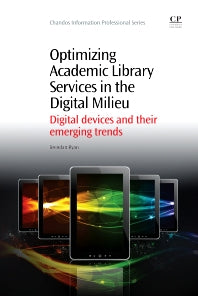Freshly Printed - allow 10 days lead
Couldn't load pickup availability
Optimizing Academic Library Services in the Digital Milieu
Digital Devices and their Emerging Trends
Identifies best practices and strategies for using digital devices (such as tablets and smartphones) and copyrighted materials in academic libraries.
Brendan Ryan (Author)
9781843347323, Elsevier Science
Paperback / softback, published 30 September 2013
196 pages
23.3 x 15.6 x 1.4 cm, 0.4 kg
The digital is the new milieu in which academic libraries must serve their patrons; but how best to utilize the slew of digital devices and their surrounding trends? Optimizing Academic Library Services in the Digital Milieu identifies best practices and strategies for using digital devices (such as tablets, e-readers, and smartphones) and copyrighted materials in academic libraries. Special consideration is given to e-books, iBooks, e-journals, and digital textbooks. This title describes how academic libraries can remain current, nimbly addressing user needs. An introduction gives an overview of technology in academic libraries, including the foundations of copyright law and user behavior in relation to digital content. Three parts then cover: digital rights management (DRM); practical approaches to e-content for librarians; and emerging pedagogy and technology. Finally, the book concludes by telling libraries how to remain agile and adaptable as they navigate the digital milieu.
List of abbreviations Acknowledgments Preface About the author Part 1: Rights Introduction Chapter 1: Copyright basics Abstract: Public domain Fair use What is copyrightable? Chapter 2: Digital rights management and the Digital Millennium Copyright Act Abstract: Digital Millennium Copyright Act TPMs and fair use Encryption and tethering Soft-use measures Chapter 3: Types of digital content Abstract: Internet Databases eBooks Chapter 4: Best practices regarding copyrights and digital content Abstract: General best practices Chapter 5: Challenges to fair use Abstract: Preservation Compromises and fair use Binary nature of code P2P Platform limiting Possibilities Part 2: Formats Introduction Chapter 6: Three components of eBooks Abstract: Container ePub Content Context What is the cloud? eBooks v. the browser stack Chapter 7: Creating eBooks Abstract: The browser stack XML HTML5 Maturation of the browser stack Popular tools Chapter 8: Touchscreen devices and apps Abstract: Introduction iOS Windows 8 Apps Conclusion Part 3: Vibrancy Introduction Chapter 9: Publishing support Abstract: Economic landscape Aggregation DIY publishing support Chapter 10: Academic support with digital content Abstract: Patron desires and use of eContent Evolution of scholarship Chapter 11: Conclusion Glossary Bibliography Index
Subject Areas: Academic & specialist libraries [GLMA], IT, Internet & electronic resources in libraries [GLF], Library & information sciences [GL]


